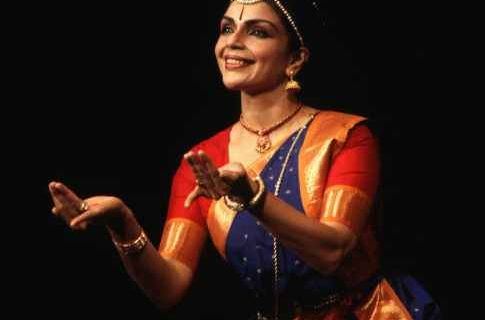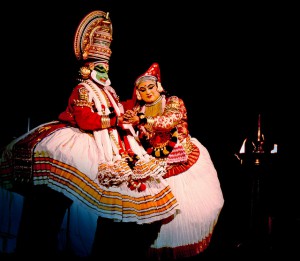
It is not entirely impossible to imagine that classical Indian dance is timeless or that the stories narrated in these dances have been handed down untouched and unshaped from ancient unrecorded times. Through dance it is easy to seek kinship with the apsaras in the epics, with the devadasis and courtesans, or watch the sensual movements and mudras like they are our last changes to find the lost language of desire. However, in a recent conversation on dance and sexuality with Bharatanatyam dancer Anita Ratnam, who has performed for both Indian and global audiences, I discovered that dance has always been malleable. It has constantly reinvented itself and learned continuously to speak a language that is relevant to the audience in attendance. Classical dance like everything else is modern.

For many of us, Bharatanatyam is one of India’s most renowned and most appreciated classical art forms. When I ask Ms. Ratnam about Bharatanatyam’s history, she talks about the modern art form that it has become. “One thing Bharatanatyam dancers must acknowledge is that the dance they perform today is a modern Bharatanatyam,” she says. “It does not have a 5000 year old history. That is just false. The Bharatanatyam of today was constituted in the 18th and 19th century. During independence it took on another modern dimension. It is India’s modern dance form of the 20th century. So we have to look at it from that modernist lens. We have tried to hitch Bharatanatyam to an ancient timeline which is not true.”
Many of us know Bharatanatyam for its ties to the Devadasi traditions. While it was banned under colonial rule for being distasteful, it was revived after independence mostly by efforts taken by Rukmini Arundale and the Kalakshetra school of dance, of which Ms. Ratnam herself is a student. While Arundale is credited with ‘reviving a tradition,’ she is often criticised particularly by feminists for ‘sanitising’ the dance form. However, Ms. Ratnam suggests that the dance form as it was practiced by the devadasis was anyhow a lost art, and Arundale could not have revived it at all without making it palatable to a conservative upper-class, coaxing them to send their young daughters and sons to learn the art. However, she cautions against the tendency to revive the ancient form of dance without completely understanding the devadasi tradition.
“Students of today cannot perform the music. They don’t know ancient Telugu, or Tamil or Sanskrit. So they only learn the movements,” she says. “There is this tendency also to learn these so-called erotic padams without actually living them. I will give you a parallel. In old Indian cinema there was the heroine and the vamp. Today the heroine is the vamp. So, today’s women are wanting to be the Sitas and the Surpanakas and the Helens without understanding what it means to be a courtesan or a devadasi. They were independently wealthy, owned property, owned homes, chose who to give their money to, had children, passed their wealth to them. You must understand how independent she was. What a feminist she was for her time! And how the English couldn’t understand independent women like that. So they had to bad women.”
Ms. Ratnam goes on to say that once the devadasi way of life ceased to exist, the desexualisation of the repertoire and choosing to go the ‘Bhakhti route’ was required in order to make dance acceptable to an audience that had lost its appreciation for women living the life of the devadasis. In a sense, the devadasi tradition had lost its relevance, and had faded to a performance that could only be partially revived on stage. The desexualisation of dance allowed its comeback, giving artistes an opportunity to view it through a modern lens and shape it to reflect modern interpretations of gender and sexuality.
Speaking to Ms. Ratnam, reminded me very much of the Malayalam film Vanaprastham (1999), an Indo-French-German production that features another South Indian dance, Kathakali. Kathakali comes from two words katha (narration) and kali (performance), and traditionally uses a complex combination of music and dance to tell mythological stories that Kerala’s temple-goers could relate to. Vanaprastam extracts Kathakali from its traditional shell, and brings it, albeit a little violently, into a modern era. The film concurrently narrates two love stories: Kunhikuttan, a low-caste, poor, aging Kathakali dancer falls in love with a rich Nair woman called Subhadra, even as he begins to play Arjuna from Subhadraharanam, a chapter in the Mahabharata, where Arjuna woos and marries Krishna’s sister, Subhadra. In the story, Kunhikuttan makes Kathakali his way of life, living the poor life of a performer with the dignity of his princely on-stage alter ego until he is forced by circumstances to separate the two identities. Vanaprastham, through Kunhikuttam, seperates Katha from Kali marking the end of an era, when Kathakali ceased to be a way of life, and artistes were forced to adapt to a new way, in which dance was only their profession.
With the death of an era, an art and its grammar fizzle away simply because of the lack of someone to translate its meaning. “Today we find a return of an interest in the erotic content,” Ms. Ratnam says, “but we don’t have mature interpreters among that style of Bharatanatyam, among the dancers. None of the divas can interpret it right. People who can interpret it like Lakshmi Vishvanathan or Bala Saraswathi’s student Shyamala are not in demand. It comes to a Catch 22 situation, where people want to see the kinetic thrills, like people jumping and leaping and all that. But the sensuality of Bharatanatyam came in a more sedate, more still and more richly soaked presence of the music and the poetry. So in saying it was sanitised it is only half true. If it was available as it was, still there would be no one to interpret it.”
While Vanaprastham speaks about a dying way of life, it succeeds as a film primarily because it shows that every art form also adapts, modernises and survives. When one interpretation of sexuality, desire and love is lost to translation, another surfaces and carries the form forward. Even as Kunhikuttan struggles to come to terms with his dual identity, his daughter learns about academies taking female students and becomes, against her mother’s wishes and her father’s traditional notions, a female performer of an art form that has traditionally been performed only by men. In Kunhikuttan’s final performance, she becomes Subhadra, learning to separate the romantic interest of her father’s on-stage character from her own off-stage identity as his daughter. In testing incest taboos, the movie shows a modern form of Kathakali where the artiste is female and also in control of her performance. Since the 1980s, Kathakali has also adapted itself for a larger Indian and global audience by moving away from Hindu narratives to stories based on Shakespearean theatre, Homer’s Greek epics and the Bible.
Similarly, several Bharatanatyam dancers including Ms. Ratnam have adapted repertoires and cast them in different molds for a modern audience. “I did not learn from a devadasi guru. I learned from a guru, in whose arsenal there was nothing more than the Bhakti tradition. So I feel that for me to listen to all these as music is very beautiful. If I choose to interpret a famous padam like Paiyyada, which is Bala Saraswati’s repertoire about a man who has left her, I would use theatre. I would keep the music integral, and use a form that would allow the body to be free, than just use mudras. That is how I would do it; use theatre as a vehicle to interpret and give it a modern twist. That is how I would approach all these erotic padams.”

There is a tendency to imagine that the narratives of classical dance are ancient legacies and that the sexualities portrayed on stage are continuous with imaginations of gender and sexuality from an ancient time. However, dancers have continuously reinterpreted desire, sexuality and love for the audience and transformed into forms that will appeal to their tastes. In one of the complete, consolidated versions of the old Sanskrit Epic Mahabharata, Subhadraharanam shows a nearly inanimate Subhadra, whom Arjuna sees, falls for and kidnaps without exchanging as much as a word with. But even in traditional Kathakali performed for an elite audience that included powerful, land-owning Nair women, Subhadra becomes an authoritative woman who desires Arjuna, desires to be taken away and even drives the chariot away from her natal home. In the film, the Nair woman Subhadra writes her own version in which Subhadra is bolder and more vocal about her desire for him, and creates on stage a space to express her desires and passions.
Ms. Ratnam too speaks about how the myths narrated in Bharatanatyam are also interpretations made through modern lenses. “Classical art is narrative based, and very often the dancer, be it a man or a woman, becomes what the story needs him or her to be. So you become a man, or a woman, or a tree, or an animal or a creature. At the same time, there is that suspension of belief. The audience knows this is a woman, but in this story, she plays a man. You have to cross gender a lot… but, there would not have been issues of sexuality, the way we understand it today impinging on classical dance practice… In that way, the stories we tell have passed through our modern lenses and are modern interpretations.”
In making these interpretations, dancers often draw inspiration from their personal lives as well. “As a single mother,” Ms. Ratnam says, “I have played the role of both father and mother. So I have played masculine roles off-stage, and I think this impacts my dance, the way I walk, the way I take a stance, the way I present myself to an audience.” She shares with me a review of her recent performance in Washington DC, where reviewer George Jackson describes her performance for the power it has. He writes, “The lift of her torso when she asserts herself is imperial. The stances she takes… leave indelible images.”
“If you think of femininity as something subtle and demure, then you could say these adjectives are ‘masculine,’” Ms. Ratnam says. “But every dancer is in touch with their feminine and masculine sides. I am very comfortable with both, and the female characters I portray are also powerful and in touch with both sides.”
As a member of the lay audience watching classical dance, I have wondered how relevant it is to me, to my life. The narratives are often old stories, which in spite of being stories I grew up with tend to feel distant. But Ms. Ratnam’s perspective, her vision to cast old tales into modern times, her concept of re-interpreting dance forms instead of mourning the loss of an older tradition, cast Bharatanatyam and classical dance in a more relevant light, and made it feel more relatable.
(A full interview with Anita Ratnam, her insights on the relevance of mythology and patriarchy in dance and cultural activism will be published on January 15,2015)